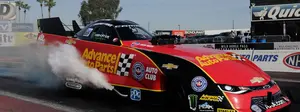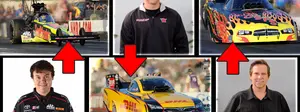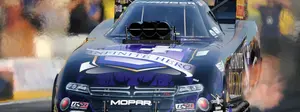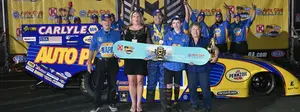

Teflon Shawn

Langdon, 33, had experienced highs and lows from a competitive standpoint, though steady support behind his efforts in his first three seasons with the Morgan Lucas Racing team and his tenure with Alan Johnson Racing never gave him reason to fear the rug being pulled out from under him. Despite being young and one of the best statistical leavers in the category, Langdon was confronted with the reality of being on the sidelines when the Qatar Racing Club suddenly withdrew its sponsorship one month prior to the start of the 2015 season.
“Last year was a whole new experience for me,” said Langdon. “Since 2009, I spent three years with Lucas and my first three years with Alan knowing that the sponsorship was never really in question. We always had things in place knowing that we would be racing a full schedule and contending for a championship. Getting word in the first few days of January last year that the sponsor pulled the plug made things very uneasy. It was definitely a shot to the gut.
“I’d been very fortunate to not have that big of a reality check in all my years in Top Fuel before last season. For me, it made me ask myself what I would do outside of racing if this goes away. I really feel like I’m in the good part of my career where I can expand myself as a driver. When you get a gut check like that, it really makes you think, ‘What do I do if this all goes away?’ You’re not invincible. At that point, you’re another driver looking for a job. It was definitely tough, but I think it helped keep me grounded. It made me think a lot more about setting myself up for the future and not living above my means. At some point, it is going to go away. Hopefully, it will be 20 years from now and not a couple years from now.”
Langdon began the season with a flurry by winning the Circle K NHRA Winternationals and recording a 3.700-second elapsed time that would stand as the quickest run in NHRA history until the Brainerd event. The team was operating race to race early in the year, and Toyota stepped up to ensure that Langdon would be racing until the end of the regular season. Langdon made the Countdown to the Championship, along the way posting a 3.662-second run in Brainerd that still stands as the quickest e.t. ever recorded.
“There was a lot of pressure on the team and the guys to perform on the racetrack in addition to finding sponsorship,” said Langdon. “Alan was very generous to use his money to keep the car running at the beginning of the year. It was rebuilding everything from square one. We were fortunate to get a win in Pomona, but it seemed to slowly trickle down after that. It was a huge learning experience for me and for all the guys. With what we had to work with, I think we did pretty darn good.”
The situation came to a head following the Chevrolet Performance U.S. Nationals when Johnson decided to park the team until primary sponsorship was acquired. However, an opportunity arose for Langdon. A ride in the Red Fuel/Sandvik Coromant dragster that Spencer Massey drove for the first 15 races of the season before parting ways with the team became available. Khalid alBalooshi provided a stopgap by driving the Don Schumacher-owned, Phil Shuler- and Todd Okuhara-tuned entry in Indy.

“It was a tough scenario putting everything together days before Charlotte,” said Langdon. “We kind of had to start fresh. Todd, Phil, and the whole team did the best they could with having me come over as a driver. It took me a couple races to get acclimated with everything – driving a canopy car, adjusting to their run procedures. It took a couple races to get to know each other, get to know my tendencies, and get to know the way they wanted to do things.
“From my standpoint, I was getting into a different car that wasn’t built for me. It was a little bit smaller in the footbox area, so it was a little bit cramped. I had to get used to getting inside the canopy. There is a noise change with it being a lot quieter in there, so you hear a different tone of the motor. I definitely like it because you can hear the tone of the motor instead of just the loud pitch of it. I think that was something that helped me out a little bit. For them, the biggest challenge in going from Spencer to Balooshi to me was the difference in weight of those drivers. It took them a little bit of time to adjust the car to be able to get the momentum and initial wheel speed up to get everything else to fall into place. There are so many things that have to happen in a short amount of time in order to get the clutch wear right. It took a little time, but I think we got a pretty good handle on that at the last couple races.”
Langdon came on strong at the end of the year to vault to No. 6 in the points standings. He bookended his season with wins in Pomona with different teams by winning the Auto Club NHRA Finals. In the final round, he recorded the team’s best run of the season at 3.715 seconds. That scenario was made possible by Langdon scoring a holeshot win over Larry Dixon to get the team out of the first round.
“The last couple races really showed what the team is capable of,” said Langdon. “We were a little behind in qualifying and had some tough draws in eliminations when we weren’t in a position to really get aggressive with the car. We definitely made some great runs in Pomona. In the final, we had a hole out at 800 feet, so there was more left in it. It was encouraging to make the final and run the team’s quickest e.t. to date.”
Weeks into the offseason, Langdon had a conversation with Johnson regarding whether sponsorship opportunities would allow AJR to field a dragster in 2016. Though they decided to part ways and seek other opportunities, Langdon again quickly landed back on his feet with Schumacher hiring him full time for 2016.


Langdon reached the winner's circle in Pomona with two different teams when he won the season opener with Alan Johnson Racing (top) and ended the year winning for Don Schumacher Racing.
“At the end of November, I had a talk with Alan to see where he was at,” said Langdon. “At that point, he didn’t have anything, and we felt that it was best at that point to go our separate ways. Alan has opportunities to stay out there tuning cars, and Don having that open seat gives me a great opportunity to race for a championship.”A few weeks into the offseason, Langdon suffered a gall-bladder attack that required surgery. Though unpleasant, the timing allowed for ample recovery time, keeping with the theme of misfortunes that ultimately were not setbacks.
“If that would’ve happened during the season, it wouldn’t have been good,” said Langdon. “It kind of goes along with everything that happened in the last year. Everything happens for a reason, and it turns out how it’s supposed to be at the end of the day.”
The uncertainty that surrounded Langdon during the 2015 season helps him appreciate going into 2016 with stability once again. As the tour’s most recent winner, he is bullish about his team and his chances.
“Coming off the win in Pomona, we feel good about everything,” said Langdon. “We’re going to have a new chassis. We’re going to have a little bit different look on the car this year. Instead of Red Fuel, it’s going to be DSR ProSeries. Along with Sandvik Coromant, we’re going to be able to continue this year. Don has a couple other things in the works that we’re excited for, which we will hopefully be able to announce soon. Other than that, we’re just trying to game-plan a little bit. We’ll take the new chassis to Phoenix and give it a whirl out there and see where we stack up.
“I feel like I’m very lucky to be where I’m at. I’m kind of an average Joe who had the opportunity to drive a Top Fuel car. I don’t think of myself as anything other than that.”



























